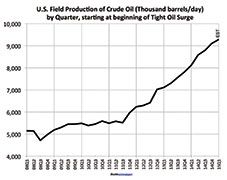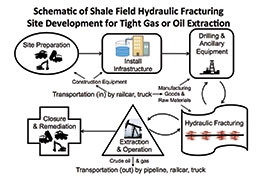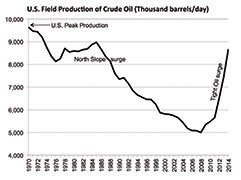John D. Jacquin, Chemark Consulting04.17.15
Growth in Energy Extraction
Last month’s Business Corner reviewed the substantial growth in U.S. energy resources extracted from tight oil and gas shale formations by hydraulic fracturing (fracking). Despite a substantial decline in global crude oil prices initiated late in 2014, a significant decrease in the number of shale drilling rigs and an unprecedented inventory surplus, U.S. production of crude oil is estimated to have continued to rise in 1Q14. Whether or not this six year growth trend will level off, or even decline in 2015, the volume of crude oil extracted is still expected to be substantial in 2015.
Two important elements required to achieve profitable business growth are developing new markets and leveraging loyalty to capitalize on the opportunities. The focus of this month’s analysis will be a review of the fracking process to extract oil and gas from tight shale formations, and the identification coatings types and related new technologies that are emerging to support this world changing event.
The Big Picture
The general hydraulic fracking process was diagramed in last month’s article. However, before any tight gas or oil can be extracted, the shale field must be developed. As shown in the simplified schematic, the site must be prepared, the infrastructure constructed, the wells must be drilled vertically and horizontally, fractured, and then the tight gas or crude oil resources can be conducted from the field. Each step of the process requires a substantial transportation component to move construction equipment and materials into the site, provide raw materials at regular intervals, and remove the crude product. Each phase of the process, including the transportation component, involves products that must be specifically coated to meet the performance requirements of the process. Further, the hydraulic fracking process has a special product coating requirement, and also uses many types of resins and specialty chemicals that are common to coating formulation.
The transportation vehicles delivering to the frack site include flatbeds, hoppers, and tank trucks or railcars. However, the high volume, reoccurring deliveries of raw materials, such as sand or water-based chemicals have the most significant impact on coatings growth. Extracted crude is usually shipped out of the shale field by pipeline or rail. Although more than 2/3 of the crude oil production is transported to refineries by pipeline, in the last six years it is estimated that crude oil shipments by rail car in North America have increased by a magnitude of 50X. That’s fifty times the volume - to around half a million rail cars in 2014. This has required a substantial effort to retrofit vehicles to transport product in and out of the site, and coatings are specified to meet the performance needs of the transported goods.
• Thus, chemical, corrosion or abrasion resistant epoxy, phenolic, 100% solids aromatic polyureas or even bis-A free epoxies may be specified for interior tanker linings. Exterior durable urethane based coatings may be specified for hoppers and tanker exteriors, over an epoxy primer.
• Due to the size of the vehicles, moderate cure temperatures and long bake times are typical, with varying metal thicknesses and film builds requiring complete through-cure.
• Pipelines are typically coated with corrosion resistant functional fusion bonded epoxy powder coatings applied via a fluidized bed to withstand underground environments.
The demand for construction vehicles has waned for building residential and commercial properties, as the new housing slump has stagnated at volumes that are only a fraction of pre-recession levels. Yet the growth in hydraulic fracking operations has boosted the “ACE” (Agricultural & Construction Equipment) market to deliver products such as tree harvesting & transport vehicles, a variety of construction and earth moving equipment, riggers, tankers, and even seismic, pumping and drilling trucks. It is due to this market that the major ACE manufacturers have reported an annual business growth of more than 10%.
• Coatings and applications techniques for these vehicles would follow along the same lines as the transportation paints listed above, with DTM (direct to metal) and two coat formulations applied to meet chemical, corrosion, weatherability and other performance requirements.
• The fracking sites contain many tanks to hold a variety of raw materials and waste products that are typically water based in nature. Depending upon the need, the tanks may be lined with an epoxy or phenolic coating to resist, for example certain chemicals or even a brine environment.
• Buildings for employees and/or equipment are often constructed from epoxy primed and polyester coated coil stock, and fractionation facilities typically need both chemical resistance and outdoor durability; either two coat systems, or urethane topcoats may be a typical choice.
• Equipment, such as generators, compressors, pumps and oil field apparatus may be powder coated with exterior durable polyester TGIC, HAA or urethane crosslinked coatings, or epoxy-polyester hybrids for interior application.
Knowledge of the value chain is often derived through building long term, loyal relationships with one’s customers. Thus, profitable growth can be achieved by supplying customers who are supporting these markets, and being able to react and deliver on evolving requirements for improved cure response, performance or environment regulations.
The development of large scale hydraulic fracturing operations in North America has introduced several substantially new and tremendously growing technologies. After the well has been drilled and stabilized, the fracturing fluid is pumped down into the well bore at high pressure to create fractures or voids through the horizontally drilled shale formations.
• The fracturing fluid is a water-based slurry containing typically close to 10% sand and a number of additive chemicals that in combination typically make up less than 1% of the fluid formulation.
• Many of these additives are used in coatings, and not unlike coating formulations, there is an evolving process, which varies by application location, to optimize performance, decrease environmental impact, and reduce the cost of the fluids.
The fractures or voids allow the tight gas or oil to permeate through the rock and be conducted upward through the well. However, the underground pressure, which drives the flow, will also cause the void space to collapse over time. This pressure and void space must be maintained to continue conduction of the crude, and this accomplished with the injection of proppants with the fractionation fluid.
• Proppants are a sieved grade of spherical sand or ceramic particles, used to pack in to and stabilize the voids, thereby maintaining the effective conduction of the crude up the well bore. However, depending on the well depth, pressure and other factors, the strength of proppants may be need to be increased, which is accomplished by coating the proppant.
• The proppant coating generally consists of a phenolic resin cured with hexamine. Other resins, such as epoxies, have also been used in to produce proppant coatings. The coating may be formulated to develop additional flow and cure in the void space, further stabilizing the proppants in the void space by “locking” the particles together.
In 2015, it is estimated that approximately 80 billion pounds of proppants will be consumed in North America, and almost 90% of that volume was sand. The use of resin coated proppants is about 5% of the total and expected to continue to grow, though at a slower pace than the general market. Yet this is a tremendous growth market, which may be accessed by working with customers that have entrée to this value chain.
During the process of fracking, portions of the horizontal lines are systematically blocked off to target fracturing in a particular area. A frac-ball, or plug, with a diameter aligned with the well bore or sleeves, is injected into the well to create the blockage. Eventually the frac-ball is removed and the well is open to conduct the crude to the well head.
• The frac-balls are essentially a composite of fiberglass and resin, typically an epoxy or phenolic.
The fracking process has grown tremendously over the last decade in North America. This has created tremendous opportunities for new business development, ranging from the mundane, such as mining and hauling sand, to exotic new technologies, such as resin coated proppants; and an overall boost in the manufacturing of equipment used in drilling operations. Growth in coatings is an inevitable and positive consequence of extracting oil and gas from tight places, and being able to leverage loyalty and customer relationships can support new growth for sustainable profitability.
Last month’s Business Corner reviewed the substantial growth in U.S. energy resources extracted from tight oil and gas shale formations by hydraulic fracturing (fracking). Despite a substantial decline in global crude oil prices initiated late in 2014, a significant decrease in the number of shale drilling rigs and an unprecedented inventory surplus, U.S. production of crude oil is estimated to have continued to rise in 1Q14. Whether or not this six year growth trend will level off, or even decline in 2015, the volume of crude oil extracted is still expected to be substantial in 2015.
Two important elements required to achieve profitable business growth are developing new markets and leveraging loyalty to capitalize on the opportunities. The focus of this month’s analysis will be a review of the fracking process to extract oil and gas from tight shale formations, and the identification coatings types and related new technologies that are emerging to support this world changing event.
The Big Picture
The general hydraulic fracking process was diagramed in last month’s article. However, before any tight gas or oil can be extracted, the shale field must be developed. As shown in the simplified schematic, the site must be prepared, the infrastructure constructed, the wells must be drilled vertically and horizontally, fractured, and then the tight gas or crude oil resources can be conducted from the field. Each step of the process requires a substantial transportation component to move construction equipment and materials into the site, provide raw materials at regular intervals, and remove the crude product. Each phase of the process, including the transportation component, involves products that must be specifically coated to meet the performance requirements of the process. Further, the hydraulic fracking process has a special product coating requirement, and also uses many types of resins and specialty chemicals that are common to coating formulation.
The transportation vehicles delivering to the frack site include flatbeds, hoppers, and tank trucks or railcars. However, the high volume, reoccurring deliveries of raw materials, such as sand or water-based chemicals have the most significant impact on coatings growth. Extracted crude is usually shipped out of the shale field by pipeline or rail. Although more than 2/3 of the crude oil production is transported to refineries by pipeline, in the last six years it is estimated that crude oil shipments by rail car in North America have increased by a magnitude of 50X. That’s fifty times the volume - to around half a million rail cars in 2014. This has required a substantial effort to retrofit vehicles to transport product in and out of the site, and coatings are specified to meet the performance needs of the transported goods.
• Thus, chemical, corrosion or abrasion resistant epoxy, phenolic, 100% solids aromatic polyureas or even bis-A free epoxies may be specified for interior tanker linings. Exterior durable urethane based coatings may be specified for hoppers and tanker exteriors, over an epoxy primer.
• Due to the size of the vehicles, moderate cure temperatures and long bake times are typical, with varying metal thicknesses and film builds requiring complete through-cure.
• Pipelines are typically coated with corrosion resistant functional fusion bonded epoxy powder coatings applied via a fluidized bed to withstand underground environments.
The demand for construction vehicles has waned for building residential and commercial properties, as the new housing slump has stagnated at volumes that are only a fraction of pre-recession levels. Yet the growth in hydraulic fracking operations has boosted the “ACE” (Agricultural & Construction Equipment) market to deliver products such as tree harvesting & transport vehicles, a variety of construction and earth moving equipment, riggers, tankers, and even seismic, pumping and drilling trucks. It is due to this market that the major ACE manufacturers have reported an annual business growth of more than 10%.
• Coatings and applications techniques for these vehicles would follow along the same lines as the transportation paints listed above, with DTM (direct to metal) and two coat formulations applied to meet chemical, corrosion, weatherability and other performance requirements.
• The fracking sites contain many tanks to hold a variety of raw materials and waste products that are typically water based in nature. Depending upon the need, the tanks may be lined with an epoxy or phenolic coating to resist, for example certain chemicals or even a brine environment.
• Buildings for employees and/or equipment are often constructed from epoxy primed and polyester coated coil stock, and fractionation facilities typically need both chemical resistance and outdoor durability; either two coat systems, or urethane topcoats may be a typical choice.
• Equipment, such as generators, compressors, pumps and oil field apparatus may be powder coated with exterior durable polyester TGIC, HAA or urethane crosslinked coatings, or epoxy-polyester hybrids for interior application.
Knowledge of the value chain is often derived through building long term, loyal relationships with one’s customers. Thus, profitable growth can be achieved by supplying customers who are supporting these markets, and being able to react and deliver on evolving requirements for improved cure response, performance or environment regulations.
The development of large scale hydraulic fracturing operations in North America has introduced several substantially new and tremendously growing technologies. After the well has been drilled and stabilized, the fracturing fluid is pumped down into the well bore at high pressure to create fractures or voids through the horizontally drilled shale formations.
• The fracturing fluid is a water-based slurry containing typically close to 10% sand and a number of additive chemicals that in combination typically make up less than 1% of the fluid formulation.
• Many of these additives are used in coatings, and not unlike coating formulations, there is an evolving process, which varies by application location, to optimize performance, decrease environmental impact, and reduce the cost of the fluids.
The fractures or voids allow the tight gas or oil to permeate through the rock and be conducted upward through the well. However, the underground pressure, which drives the flow, will also cause the void space to collapse over time. This pressure and void space must be maintained to continue conduction of the crude, and this accomplished with the injection of proppants with the fractionation fluid.
• Proppants are a sieved grade of spherical sand or ceramic particles, used to pack in to and stabilize the voids, thereby maintaining the effective conduction of the crude up the well bore. However, depending on the well depth, pressure and other factors, the strength of proppants may be need to be increased, which is accomplished by coating the proppant.
• The proppant coating generally consists of a phenolic resin cured with hexamine. Other resins, such as epoxies, have also been used in to produce proppant coatings. The coating may be formulated to develop additional flow and cure in the void space, further stabilizing the proppants in the void space by “locking” the particles together.
In 2015, it is estimated that approximately 80 billion pounds of proppants will be consumed in North America, and almost 90% of that volume was sand. The use of resin coated proppants is about 5% of the total and expected to continue to grow, though at a slower pace than the general market. Yet this is a tremendous growth market, which may be accessed by working with customers that have entrée to this value chain.
During the process of fracking, portions of the horizontal lines are systematically blocked off to target fracturing in a particular area. A frac-ball, or plug, with a diameter aligned with the well bore or sleeves, is injected into the well to create the blockage. Eventually the frac-ball is removed and the well is open to conduct the crude to the well head.
• The frac-balls are essentially a composite of fiberglass and resin, typically an epoxy or phenolic.
The fracking process has grown tremendously over the last decade in North America. This has created tremendous opportunities for new business development, ranging from the mundane, such as mining and hauling sand, to exotic new technologies, such as resin coated proppants; and an overall boost in the manufacturing of equipment used in drilling operations. Growth in coatings is an inevitable and positive consequence of extracting oil and gas from tight places, and being able to leverage loyalty and customer relationships can support new growth for sustainable profitability.





